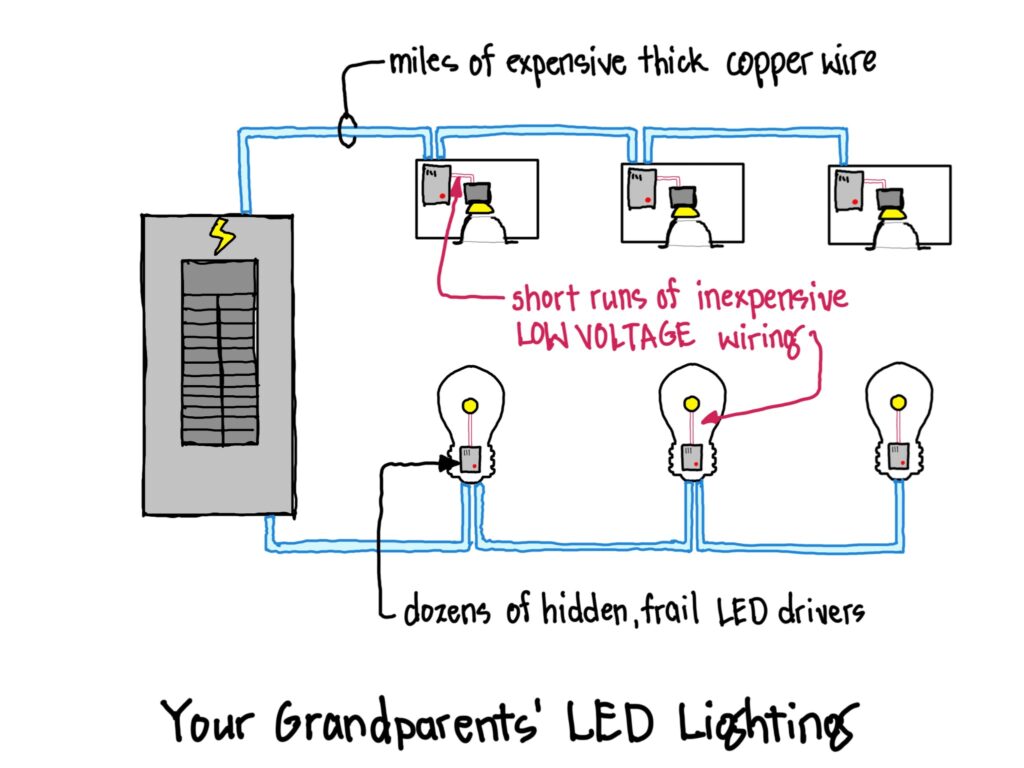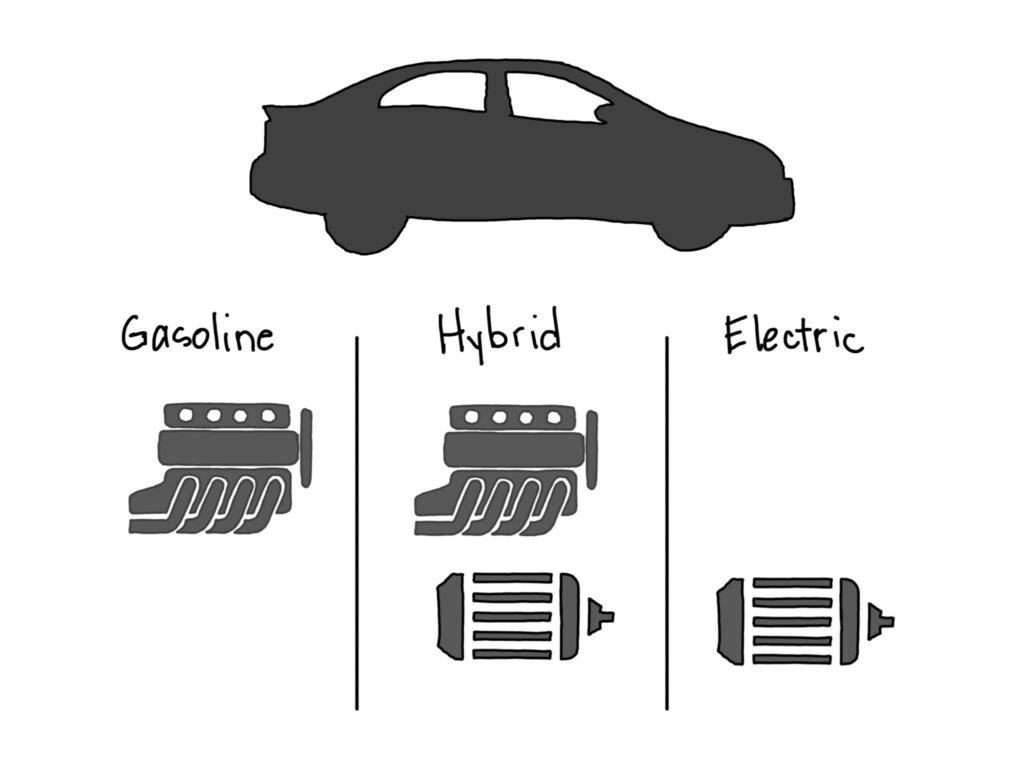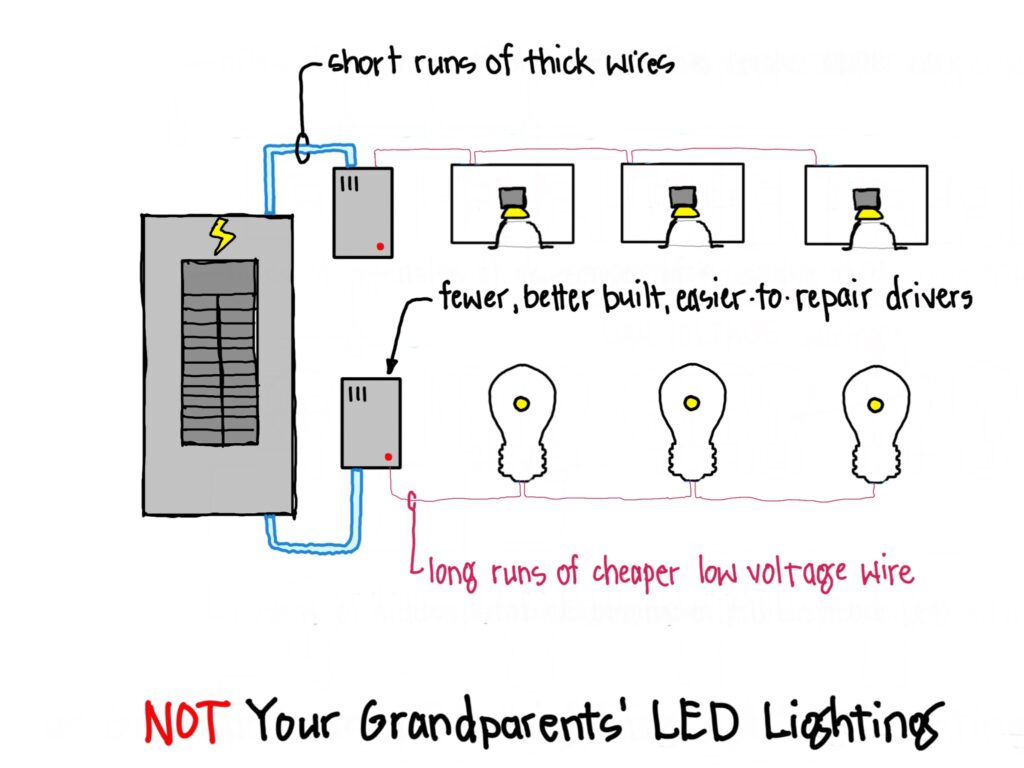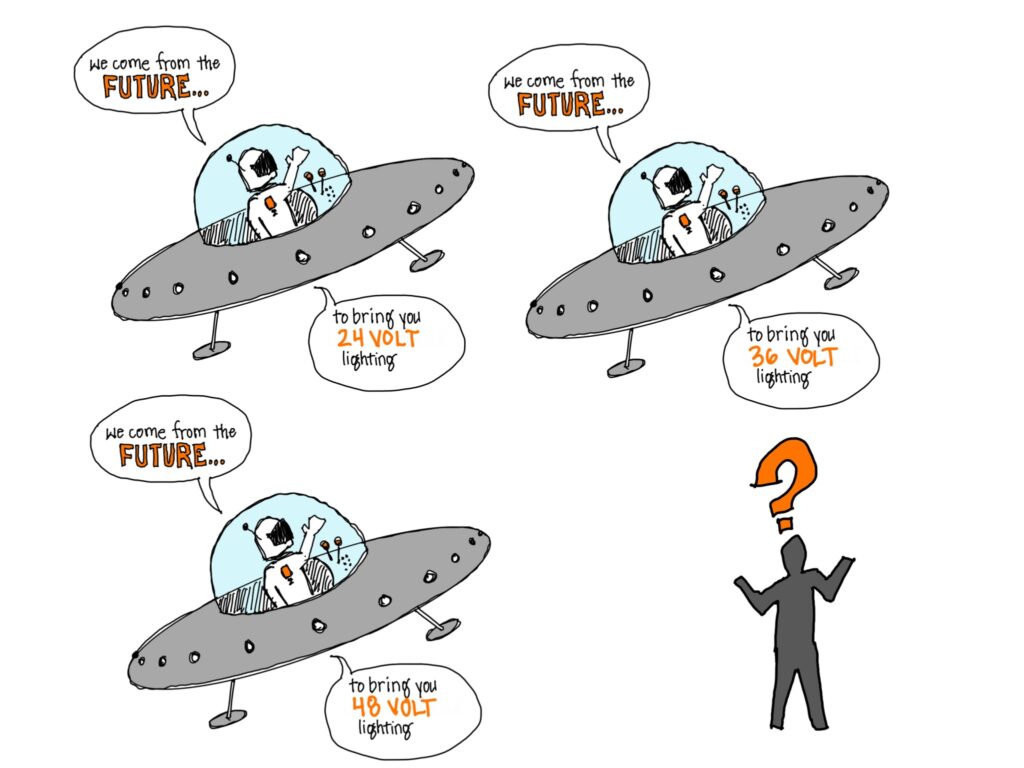My Gear Talk series is an excuse to geek out a bit while attempting to simplify some of the complex conversations we have about lighting. It is less about the theory, science, and application and more about the tools. And one of those tools has almost nothing to do with the photons themselves: voltage.

We live in an era of LED lighting. Over the past twenty years we moved away from halogen/incandescent as our primary light source, fundamentally changing the mechanics that had driven electric lighting’s first century. LED’s offer more lumens per watt than even compact fluorescent and fit into smaller and smaller spaces, opening new frontiers for illumination. We need only 10% of the power previously used for electric lighting to deliver the same output. Yet almost every house built today is still wired for 100% of the energy draw. Every LED is low voltage, yet we still deliver higher line voltage power throughout the house. We seem to be stuck, in a sense, with hybrid cars.

Our current residential lighting paradigm- line voltage wiring to dozens (or hundreds) of little drivers scattered throughout the house- is somewhat analogous to our current mode of transportation. The Toyota Prius, arguably the most successful gas/electric hybrid car, ushered in a new era in transportation. Virtually every previous automobile used gasoline or diesel fuel to spin an internal combustion engine; the hybrid auto added a battery and electric motor for increased efficiency. Our little 2012 baby Prius gave us 70mpg on a trip back from the park last week (typical in-town efficiency is in the upper 50’s). The hybrid automobile has both the “line voltage” system of the past and the “low voltage” system of the future. It is better…but not the best.
The Prius and other hybrids are quickly falling out of favor. Last year Toyota sold about 50,000 of them – and Tesla sold nearly one million full electric automobiles. The switch is on to automobiles that let go of the combustion engine, and 50mpg is starting to look like a waste. Residential lighting should also move away from our current hybrid system, but why?

There are several key reasons why low voltage lighting is all but inevitable, the first of which is money. Copper, the primary metal used in residential wiring, has to be dug out of the ground, refined, and spun into wire. Thinner wires are cheaper, but we are still wiring homes with the same wiring as the last fifty years despite dropping power consumption by 90% or more. You could say that 90% of the copper in our lighting wiring is mined, refined, manufactured, shipped, sold, and installed for absolutely no reason. This costs every homeowner more money than needed. Multiply that by the 1.5 million new homes expected to start this year in the US alone, and you could have billions of dollars of copper wasted annually. Builders and homeowners, once they figure this out, will have a compelling financial reason to switch to low voltage distribution for their lighting. Money talks.
I care about cost, but I also care about maintenance and longevity. Scroll back up to the “Your Grandparents LED Lighting.” See the tiny, frail, hidden drivers? These devices convert the higher line voltage power to the (safer) low voltage wiring needed by the LEDs. How low? An LED might need 1-3 volts. We send it 110-120 volts.
These drivers are made to be as small and inexpensive as possible, which also means they do not last forever. LEDs have exceptionally long life cycles – think in terms of decades of use – but the drivers are prone to failure much earlier. Which means you have to dig into the ceiling and replace the component or throw away the LED bulb, all over the house. Low voltage lighting systems use fewer, better built drivers that can be located in a utility closet and lower the maintenance difficulty substantially.
Saving money and reducing maintenance hassle are two good reasons to switch to low voltage lighting now, but the move from fixed white light to color-tuning light will make it even more compelling. Virtually all LED tape light is already low voltage, and color-changing lighting, because it needs “wiring” for each color, is especially suited to the future of wiring. In other words, most of the homes our team designs have some low voltage wiring in them and the percentage is rising as we move away from fixed white lighting to better solutions.
Convinced? There are more reasons to switch to low voltage – think of the environmental cost of wasting 90% of the copper wiring in a home – but most homes are still line voltage power to tiny drivers everywhere. We’re living in a hybrid world, but the technology exists to move into the electric car future. We just need to make the choice.

So why are we not already using low voltage lighting everywhere? Because manufacturers are choosing competition over cooperation. If you’re old enough, think Betamax over VHS. Instead of developing industry standards for low voltage lighting (VHS), each manufacturer is developing its own method of driving and distributing power for lighting (Betamax). Some manufacturers are willing to cooperate, but many intentionally lock down their technology with patents and proprietary protocols so that you cannot mix and match. Imagine if your house was wired up and could only use lighting from a single manufacturer, for the rest of the home’s life. That is happening today. We are told that this reality is to allow the manufacturer to guarantee the system will work, but that is a smokescreen to protect the profit-centered motives. VHS tapes made by one manufacturer could be played in any VHS player. We’re smart enough to figure this out, but until we cooperate, low voltage lighting may continue to languish.
That means homeowners will keep paying extra for copper wiring they don’t need. That means early adopters may be stuck in homes that can only have lighting from one manufacturer, for decades and decades. We are paying for obsolete technology or paying for the privilege to be locked into a single manufacturer. It just doesn’t make sense.
Lighting wiring will move to low-voltage distribution. The only questions are when will it happen- and how much copper and money and time and resources will we waste before we work together to take this important step forward?
